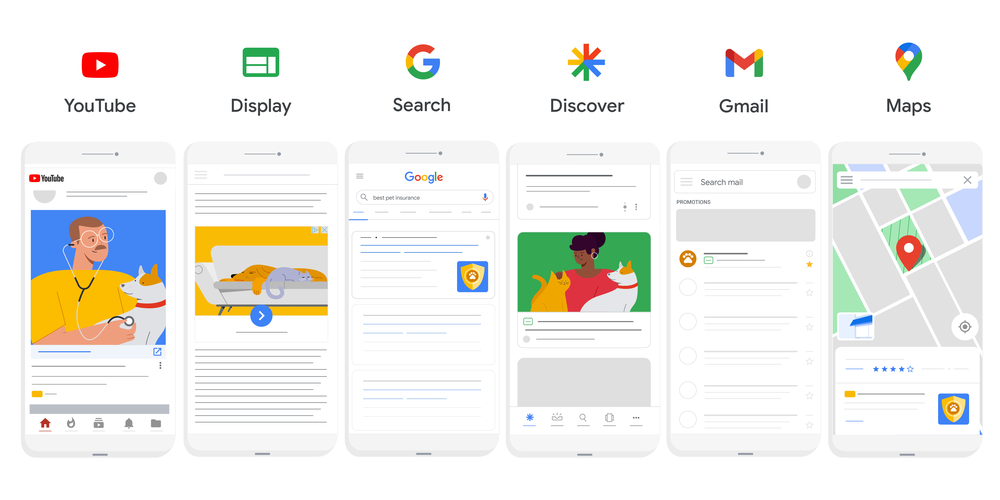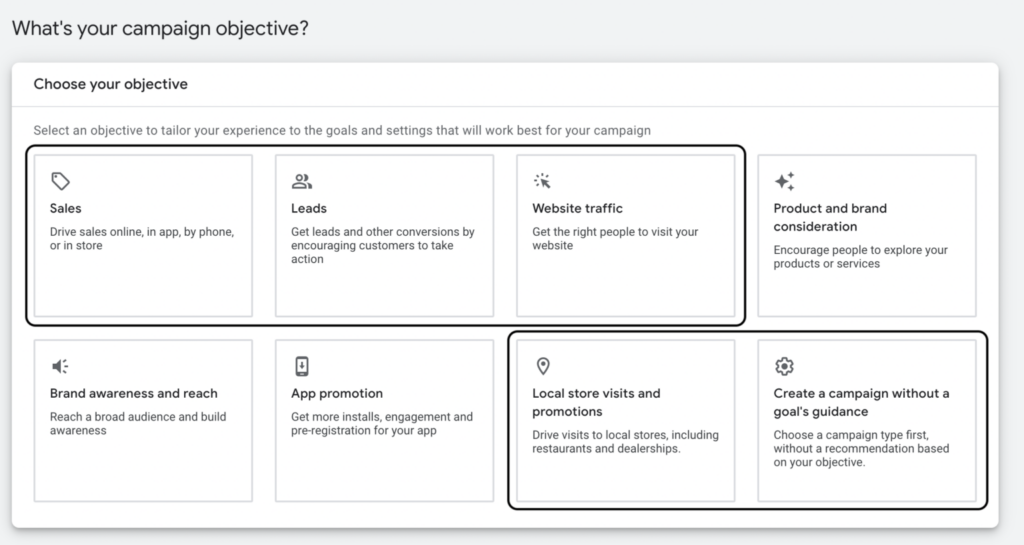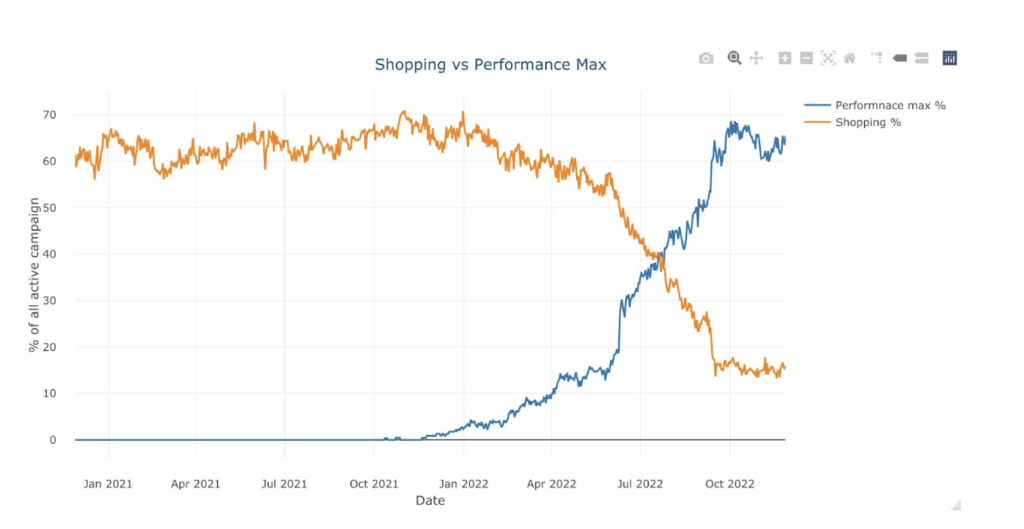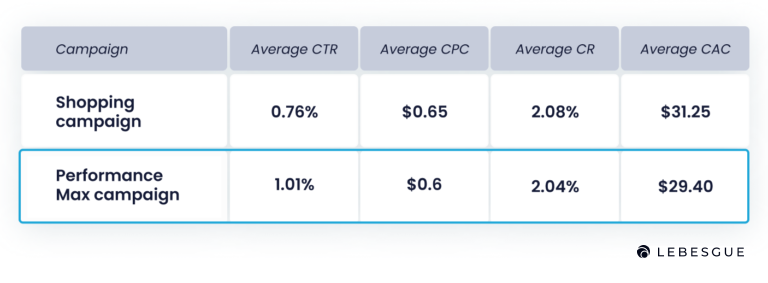Performance Max campaigns allow performance advertisers to use a single campaign to access all of their Google Ads inventory. It’s designed to help you find more converting customers across all of Google’s channels like YouTube, Display, Search, Discover, Gmail, and Mail.

In this blog post we’ll focus on the following:
- pros and cons of the Performance Max campaign
- differences between the Performance Max and Shopping campaign
- the benchmark CTR for Performance Max campaigns
- the benchmark CPC for Performance Max campaigns
- the benchmark conversion rate (CR) for Performance Max campaigns
- the benchmark CAC and ROAS for Performance Max campaigns
What is a Performance Max campaign?
Performance Max is a campaign type in Google Ads designed to help businesses achieve their performance goals, such as increasing website traffic, leads, or sales.
They use machine learning algorithms to optimize ad delivery in real-time. Ads are shown to be the most relevant and likely to convert customers.
This means that the ads will be shown to customers who are more likely to take the desired action.

Performance Max campaigns are particularly well-suited for businesses that have well-defined performance goals and want to maximize the return on their advertising investment.
They are a good option for businesses that have a limited budget and want to get the most value out of their advertising spend. However, Performance Max campaigns are more complex to set up and manage than other campaign types, so they are not suitable for all businesses.
PROS of the PMax campaign
Here are some benefits of using Performance Max campaigns:
- Completely automated: Performance Max campaigns are completely automated, which means that they require minimal ad management. This is a good option for businesses that don’t have the time or resources to manage a more complex campaign.
- Simple to adjust: Performance Max campaigns are very simple to adjust, as you only need to set up your desired target return on ad spend (ROAS) and budget. This is a good option for businesses that want to quickly and easily adjust their advertising efforts based on their performance goals.
- Easy to set up for eCommerce businesses: Performance Max campaigns are very easy to set up for eCommerce businesses on platforms like Shopify, as these platforms are tightly integrated with Google Ads. This make it easier for businesses to get started with performance-based advertising and start seeing results quickly.
- Real-time optimization: Performance Max campaigns use machine learning algorithms to optimize ad delivery in real-time, showing the ads to the most relevant and likely to convert users.
Overall, Performance Max campaigns are a good option for businesses that have well-defined performance goals and a limited budget, and are looking for a targeted and cost-effective way to reach their audience.
CONS of the PMax campaign
There are also some drawbacks to using Performance Max campaigns:
- Complexity: Performance Max campaigns are more complex to set up and manage than other campaign types. Especially, if you are not using an eCommerce solution like Shopify that is tightly integrated with Google Ads.
- Limited control: Performance Max campaigns are automated and completely black-box. That means that businesses have limited control over the targeting, ad delivery, and other aspects of the campaign. While businesses set their performance goals and budget, they have less control over the specific targeting and ad delivery than they would with a manually managed campaign.
- Limited insights: Compared to Shopping or Search campaigns, Performance Max does not give you any insight on keywords or phrases that convert customers. The most you get is “top signals” for conversions, which are usually tightly related to your brand name.
Difference between the Performance Max and Shopping campaign
Starting in September 2022, Google began automatically switching Shopping campaigns to Performance Max campaigns. This is clearly seen in the attached graph, which shows the trend of Shopping campaign adoption over time.
At Lebesgue, we prefer Shopping campaigns to Performance Max campaigns, as they offer more control and insights.
However, since Performance Max campaigns are now mandatory, there is nothing to do but adjust for them and maximize your performance.

Here is a table with key metrics comparison between Shopping campaigns and Performance Max:

As can be seen, Google managed to improve average CTR with the Performance Max campaign, decreasing average CAC by 6%.
The Performance Max Campaign's Benchmark CTR
The average CTR for the Performance Max campaign is 1.19%, meaning that about 1% of users who see your ads click on them. This CTR is relatively low compared to the average CTR for Google Ads, which is around 1.66%.
This isn’t surprising, as very specific search campaigns (like brand campaigns, competitor campaigns or long-tail keyword campaigns) can achieve very high CTR.
In addition, optimizing for link clicks and cheap traffic can boost your ads CTR (and negatively impact your CR). Those optimization strategies should be avoided when running ads for a Shopify or other eCommerce store.
If you have a CTR below 1%, it can indicate that the ads are not resonating with the target audience or that they are not being shown to the right users. To improve the CTR of your Performance Max campaign, you may want to consider optimizing the ad copy, targeting, and placement to make the ads more relevant and appealing to the target audience.
The Performance Max Campaign's Benchmark CPC
The average CPC for a Performance Max campaign is $0.68, which means that you are paying an average of $0.68 each time a user clicks on one of your ads. This CPC is relatively low compared to the average CPC in Google Ads, which is around $0.85.
If you’re not running a Performance Max campaign yet, and your CPC is too high – this is a good moment to start it.
The Performance Max Campaign's Benchmark CR
The average CR for Performance Max campaigns that are optimized for the Purchase event is 1.83%.
This conversion rate is similar to the average conversion rate for all campaign types on Google Ads, which is 1.96%. Conversion rate is an important metric for evaluating the effectiveness of a campaign, as it indicates the percentage of users who are taking the desired action after clicking on an ad.
A high conversion rate can indicate that the ads are effective at driving conversions, while a low conversion rate can indicate that the ads or landing pages are not performing well. A specific case is when ads have a high (above average) CTR and below average CR. That means the landing page is the weak part of your checkout process, and you should improve your website user experience.
The Performance Max Campaign's Benchmark CAC and ROAS
The average customer acquisition cost (CAC) for your Performance Max campaign is $17.08.
This means that it costs an average of $17 to acquire a new customer through the campaign. However, CAC can vary widely depending on the industry, the average order value of the product, the target audience, and other factors.
Moreover, the average return on ad spend (ROAS) for a Performance Max campaign is 125%, which means that you should be generating an average of $125 in revenue for every $100 that you spend on the campaign.

A high CAC or low ROAS can indicate that the campaign is not as cost-effective as it could be, or that there are issues with the targeting, ad copy, or landing pages that are causing the campaign to be less effective at driving conversions.
To improve the CAC/ROAS of your Performance Max campaign, you want to consider optimizing the targeting, ad copy, and landing pages to make them more relevant and persuasive and adjusting the bid strategy to ensure that the ads are being shown to the most relevant and likely to convert users.
Summing Up
It’s important to note that these performance benchmarks are averages based on data from over 5,000 Shopify eCommerce businesses, and they may not be representative of the performance of a specific business.
To sum it all up, Performance Max will, on average, bring better results than the Shopping campaign did, but at the cost of limited insights on keyword performance.
Frequently Asked Questions about Performance Max Campaigns
Performance Max is a goal-based campaign type in Google Ads that uses machine learning to optimize ad performance across all Google properties (Search, Display, YouTube, Gmail, and Discover). Advertisers provide assets like text, images, and videos, as well as audience signals, and Google’s AI delivers ads across the most effective channels to meet the specified conversion goals.
Performance Max is ideal for goals like driving online sales, generating leads, or boosting in-store visits. It works best when you have clear conversion actions set up in your Google Ads account and are focused on maximizing ROI.
Audience targeting is guided by audience signals. You provide data like customer lists, website visitors, or audience segments (e.g., demographics or interests), which help Google’s AI prioritize whom to show ads to. However, Google also expands targeting beyond your signals, leveraging its machine learning to find high-performing audiences.
Audience exclusions are limited in Performance Max campaigns. While you can exclude audiences at the account level (e.g., existing customers from remarketing lists), direct exclusions by channel or placement (e.g., YouTube or Display) aren’t currently supported.
Google intentionally limits detailed placement and channel data to simplify reporting and emphasize holistic performance. Performance Max prioritizes overall goal achievement rather than granular channel-specific optimization.
In Lebesgue: AI CMO, you can view how your ad spend is distributed across different Google networks (e.g., Search, YouTube, Display) within your Performance Max campaigns. This feature provides an approximate breakdown based on available Google Ads data, offering insights into where your budget is being allocated.
By understanding this distribution, you can assess which networks are driving the most value for your business and refine your strategy for future campaigns. Keep in mind that these numbers are estimates, as Google Ads does not provide precise breakdowns for Performance Max campaigns.
No, video ads are not required, but they are strongly recommended. If you don’t upload a video asset, Google will auto-generate a video using your other assets. These auto-generated videos may not align perfectly with your brand’s style, so it’s better to create and upload your own.
This can happen if your campaign’s targeting is too narrow, conversion goals are not well-optimized, or there’s insufficient data for Google’s algorithm to scale. To fix this, ensure your audience signals are broad, check your bidding strategy, and confirm your conversion tracking is properly set up.
- Review and refine your audience signals to target higher-quality users.
- Ensure your assets (images, text, and videos) are relevant and high-quality to improve engagement.
- Adjust your bid strategy (e.g., target ROAS or CPA) to better align with your performance goals.
- Monitor the campaign for several weeks, as Performance Max requires time to learn and optimize.



